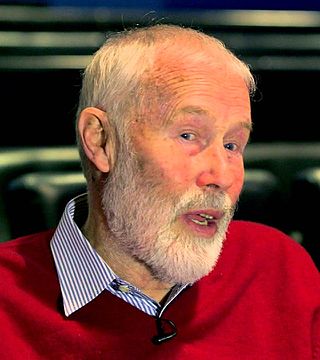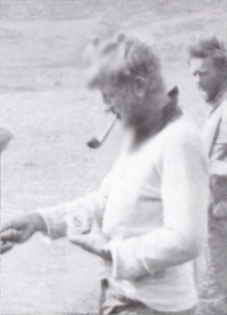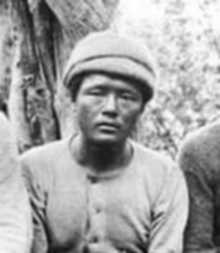
Jim Perrin (born 30 March 1947), is an English rock climber and travel writer.

Jim Perrin (born 30 March 1947), is an English rock climber and travel writer.
Jim Perrin was born Ernest James Perrin [1] in Manchester, England, to a family of Huguenot descent. His father played rugby league for Salford in the late 1930s.[ citation needed ]
As a writer, Perrin has made regular contributions on travel, mountaineering, literature, art, and the environment to a number of newspapers and climbing magazines, and continues to do so as a country diarist for The Guardian and a columnist in The Great Outdoors magazine. As a climber, he has developed many new routes, particularly on the Derbyshire gritstone outcrops, in North Wales and on the sea cliffs of Pembrokeshire, as well as making solo ascents of a number of difficult established routes, and also free ascents of previously aid-assisted climbs in Wales and Scotland.
For many years he has contributed mountaineering obituaries for The Guardian (for example, on Patrick Monkhouse, Lord Hunt, Sir Jack Longland, Sir Edmund Hillary, Brede Arkless, John Streetly, David Cox, Kevin FitzGerald, Robin Hodgkin, and others), [2] and also for The Daily Telegraph . He also wrote many essays for The Daily Telegraph travel supplement, most of which are collected in Travels with the Flea.
Perrin has twice won the Boardman Tasker Prize for Mountain Literature, first for Menlove (1985), his biography of John Menlove Edwards, and again as joint winner (alongside Andy Cave's Learning to Breathe) for The Villain (2005), a biography of Don Whillans. [3] Several of his other books have been shortlisted for this award. He has won the Mountaineering History Prize at Banff Mountain Book Festival for The Villain (2005), and the Mountaineering Literature Prize for The Climbing Essays (2006), which was also short-listed for the Wales Book of the Year Award. His Shipton and Tilman: The Great Decade of Himalayan Mountaineering won the Kekoo Naoroji Prize for Himalayan Literature in 2014. He is a Fellow of the Welsh Academy, [4] an Honorary Fellow of Bangor University.
Below is a partial list of books by Perrin listed by Amazon as in print (on 7 November 2016):
The following are out of print:

Sir Christian John Storey Bonington, CVO, CBE, DL is a British mountaineer.
Peter Boardman was an English mountaineer and author. He is best known for a series of bold and lightweight expeditions to the Himalayas, often in partnership with Joe Tasker, and for his contribution to mountain literature. Boardman and Tasker died on the North East Ridge of Mount Everest in 1982. The Boardman Tasker Prize for Mountain Literature was established in their memory.
The Boardman Tasker Prize for Mountain Literature is an annual prize of £3,000 awarded by the Boardman Tasker Charitable Trust to an author or authors for "an original work which has made an outstanding contribution to mountain literature". The prize was established in 1983 in memory of British climbers Peter Boardman and Joe Tasker, both of whom wrote books about their mountaineering expeditions, after their deaths on the northeast ridge of Mount Everest in 1982. It can be awarded for a piece of fiction or non-fiction, poetry or drama, although the work must have been written in English. The prize is announced at the annual Kendal Mountain Festival.

Donald Desbrow Whillans was an English rock climber and mountaineer. He climbed with Joe Brown and Chris Bonington on many new routes, and was considered the technical equal of both.

Eric Earle Shipton, CBE, was an English Himalayan mountaineer.

Major Harold William Tilman, CBE, DSO, MC and Bar, was an English mountaineer and explorer, renowned for his Himalayan climbs and sailing voyages.

John Angelo Jackson was an English mountaineer, explorer and educationalist.

Francis Sydney Smythe, better known as Frank Smythe or F. S. Smythe, was an English mountaineer, author, photographer and botanist. He is best remembered for his mountaineering in the Alps as well as in the Himalayas, where he identified a region that he named the "Valley of Flowers", now a protected park. His ascents include two new routes on the Brenva Face of Mont Blanc, Kamet, and attempts on Kangchenjunga and Mount Everest in the 1930s. It was said that he had a tendency for irascibility, something some of his mountaineering contemporaries said "decreased with altitude".
Dermot Somers is an Irish mountaineer, explorer, writer, and broadcaster. He was educated in the Irish-speaking Coláiste Mhuire, Dublin, and graduated from University College Dublin with a BA and HDipEd, and worked for a time as a teacher, before concentrating full-time on writing, broadcasting, and travelling. He now lives in Drogheda.
The Rock and Ice Club was an English climbing club formed by a group of Manchester climbers. The group regularly climbed on the weekends and met in the week to discuss the past weekends climbs and plan their future trips.
Precipitated by unexpected permission from Tibet, the 1935 British Mount Everest reconnaissance expedition was planned at short notice as a preliminary to an attempt on the summit of Mount Everest in 1936. After exceptionally rancorous arguments involving the Mount Everest Committee in London, Eric Shipton was appointed leader following his successful trekking expedition to the Nanda Devi region in India in 1934.

Leslie Vickery Bryant, known as Dan Bryant, was a New Zealand school teacher and a mountain climber. He was a member of the 1935 British Mount Everest reconnaissance expedition, which was a preliminary to the full expedition of 1936 that attempted the summit. However in 1935 Bryant did not acclimatise well to altitude above 23,000 feet (7,000 m), and so was not included in the party for 1936. He was a very accomplished ice climber, and was well-liked on expeditions. These two factors led, indirectly, to his compatriot Edmund Hillary becoming a member of the successful 1953 British Mount Everest expedition.
The 1936 British Mount Everest expedition was a complete failure, and raised questions concerning the planning of such expeditions. This was Hugh Ruttledge's second expedition as leader. Heavy snows and an early monsoon forced their retreat on several occasions, and on the final attempt two climbers narrowly survived an avalanche. This was the first expedition in which climbers were able to carry portable radios.

Led by Bill Tilman, the 1938 British Mount Everest expedition was a low-key, low-cost expedition which was unlucky in encountering a very early monsoon. The weather conditions defeated the attempts to reach the summit. The North Col was climbed for the first time from the west and an altitude of 27,200 feet (8,300 m) was reached on the North Ridge.

The Shipton–Tilman Nanda Devi expeditions took place in the 1930s. Nanda Devi is a Himalayan mountain in what was then the Garhwal District in northern India, just west of Nepal, and at one time it was thought to be the highest mountain in the world.

Ang Tharkay was a Nepalese mountain climber and explorer who acted as sherpa and later sirdar for many Himalayan expeditions. He was "beyond question the outstanding sherpa of his era" and he introduced Tenzing Norgay to the world of mountaineering.
After World War II, with Tibet closing its borders and Nepal becoming considerably more open, Mount Everest reconnaissance from Nepal became possible for the first time culminating in the successful ascent of 1953. In 1950 there was a highly informal trek to what was to become Everest Base Camp and photographs were taken of a possible route ahead. Next year the 1951 British Mount Everest reconnaissance expedition reconnoitred various possible routes to Mount Everest from the south and the only one they considered feasible was the one via the Khumbu Icefall, Western Cwm and South Col. In 1952, while the Swiss were making an attempt on the summit that nearly succeeded; the 1952 British Cho Oyu expedition practised high-altitude Himalayan techniques on Cho Oyu, nearby to the west.
The 1951 British Mount Everest reconnaissance expedition ran between 27 August 1951 and 21 November 1951 with Eric Shipton as leader.

Pasang Kikuli (1911–1939) was a Nepalese mountain climber and explorer who acted as sherpa and later sirdar for many Himalayan expeditions. He died on the 1939 American Karakoram expedition to K2, attempting to rescue a stranded climber.
Kenneth John Wilson was a British writer, publisher and editor of books and magazines about climbing and mountaineering. The British Mountaineering Council's Summit Magazine described him as "one of the most influential voices in British climbing". In 1974 he edited and contributed to the first editions of the book Hard Rock which The Guardian considered was "among the most influential climbing books of the 20th century."